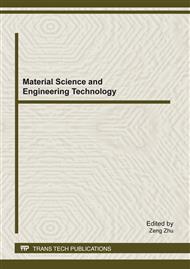[1]
Z.Q. Yang, Q.S. Lu: Science in China Series Vol. 51 (2008), p.687.
Google Scholar
[2]
A. L Ricardo, M. G Rafael: Chaos, solitons and fractals Vol. 37 (2008), p.539.
Google Scholar
[3]
C.X. Han, J. Wang, B. Deng: Chaos, solitons and fractals Vol. 41 (2009), p. (2045).
Google Scholar
[4]
W.Y. Jin, J.X. Xu, Y. Wu: Chinese Physic Vol. 13 (2004), p.335.
Google Scholar
[5]
A.L. Hodgkin, A.F. Huxley: Bulletin of Mathematical Biology Vol. 52 (1990), p.25.
Google Scholar
[6]
J. Cronin, in: Mathematical aspects of Hodgkin-Huxley neural theory. / Cambridge University Publising, Cambridge, England (1987), in press.
Google Scholar
[7]
S. Doi, S. Nabetani, S. Kumagai: Biol Cybern Vol. 85 (2001), p.51.
Google Scholar
[8]
J. Wang, J.M. Geng, X.Y. Fei: Chaos, Solitons & Fractals Vol. 23 (2005), p.973.
Google Scholar
[9]
R.S. Paul, J.N.W. David: Bulletin of Mathematical Biology Vol. 62 (2000), p.695.
Google Scholar
[10]
Q.S. Lu, Z.Q. Yang, L.X. Duan, H.G. Gu, W. Ren: Chaos, Solitons Vol. 40 (2009), p.577.
Google Scholar
[11]
T.R. Chay, J. Keizer: Biophysical Journal Vol. 42 (1983), p.181.
Google Scholar
[12]
T.R. Chay: Physica D Vol. 16 (1985), p.233.
Google Scholar
[13]
T.R. Chay, Y.S. Lee, and Y.S. Fan: Int. J. Bifurc. Chaos Vol. 5 (1995), p.595.
Google Scholar
[14]
X.L. Li, B.Z. Liu, J.H. Peng: Acta Biochim Biophys Sin. Vol. 13 (1997), p.626.
Google Scholar
[15]
Z.Q. Yang, Q.S. Lu, H.G. Gu: Int. J. Bifurc Chaos Vol. 14 (2004), p.4143.
Google Scholar
[16]
D.L. Xu, F.F. Lu: Chaos, Solitons and Fractals Vol. 25 (2005), p.361.
Google Scholar
[17]
B. Deng, J. Wang, Y.Q. Che: Chaos Vol. 19 (2009), p.015105. 1.
Google Scholar
[18]
X.L. Yang, W. Xu, Z.K. Sun: Physics Letters A Vol. 364 (2007), p.378.
Google Scholar
[19]
H.U. Voss, J. Timmer, J. Kurths: Int. J. Bifurcation and Chaos Vol. 14 (2004), p. (1905).
Google Scholar
[20]
G. Ullah, S.J. Schiff: Physical Review E Vol. 79 (1) (2009), p.040901. 1.
Google Scholar
[21]
J.F. SchifS, T. Sauer: Journal of Neural Engineering Vol. 5 (2008), p.1.
Google Scholar
[22]
R.E. Kalman, R.C. Bucy: J. Basic Eng. Vol. 82 (1960), p.35.
Google Scholar
[23]
R.C. Kalman, R.C. Bucy: J. Basic Eng. Vol. 83, p.95.
Google Scholar
[24]
S.J. Julier, J.K. Uhlmann: Proc. IEEE Vol. 92 (2004), p . 401.
Google Scholar
[25]
L. Ljung: IEEE Trans on Automatic Control Vol. 24 (1979), p.36.
Google Scholar
[26]
S. J Sauer, t. Center: Journal of Neural Engineering Vol. 5 (2008), p.1.
Google Scholar


